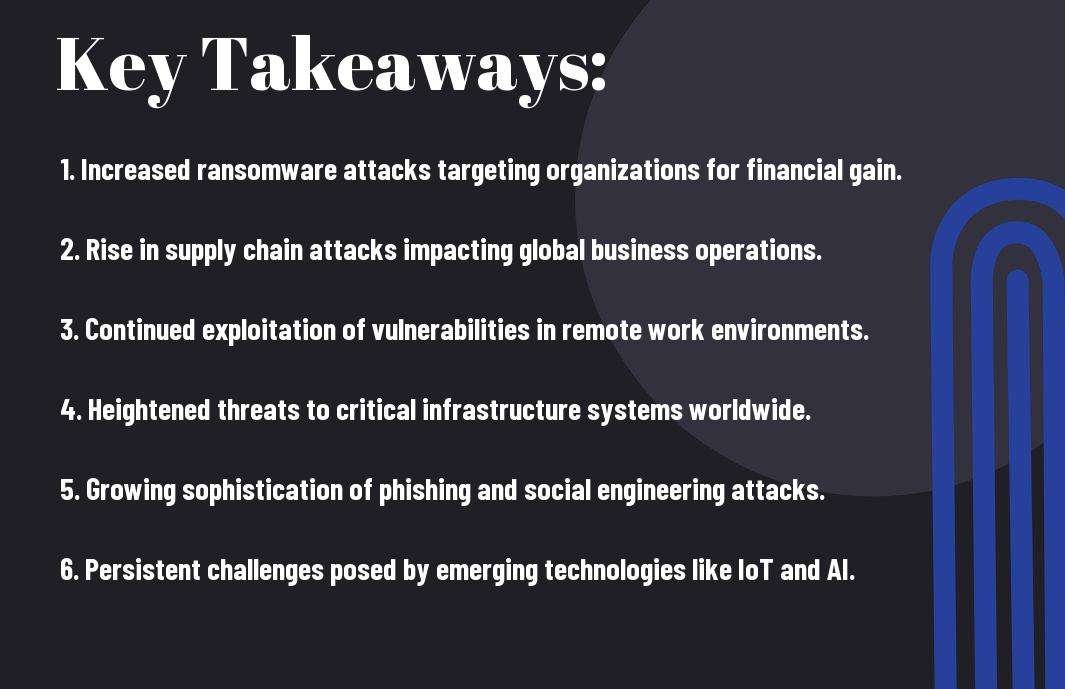As we step into 2024, dear readers, I must warn you of the top security risks that loom ominously on the horizon. In this digital age where cyber threats evolve rapidly, protecting your personal information and data has never been more crucial. From rampant ransomware attacks to sophisticated phishing schemes, staying vigilant and informed is your greatest defense. Let us navigate the turbulent seas of online security together, for forewarned is forearmed.
Key Takeaways:
- Inadequate Data Protection: With the increasing amount of data being generated and stored, organizations need to be vigilant in safeguarding sensitive information to prevent data breaches.
- Ransomware Attacks: The looming threat of ransomware attacks can disrupt business operations and lead to financial losses unless organizations prioritize robust cybersecurity measures.
- IoT Vulnerabilities: The proliferation of Internet of Things (IoT) devices presents a significant security risk, as these interconnected devices can be exploited by cybercriminals to gain unauthorized access.

Emerging Threats
Rise of AI-Powered Attacks
Your security landscape is evolving rapidly, and one of the emerging threats to watch out for in 2024 is the rise of AI-powered attacks. Emerging technologies like artificial intelligence are being leveraged by cybercriminals to launch sophisticated and automated attacks that can evade traditional security measures. This means that your data and systems are at a higher risk of being compromised without you even realizing it.
Increased Use of Social Engineering
With cybercriminals becoming more adept at exploiting human psychology, the increased use of social engineering is another threat on the horizon for 2024. This tactic involves manipulating individuals into divulging confidential information or performing actions that may compromise security. Be wary of phishing emails, fake websites, and other social engineering tactics designed to trick you into revealing sensitive data.
Plus, cybercriminals are increasingly combining social engineering with AI technologies to create more convincing and targeted attacks. It’s crucial to educate yourself and your team about the dangers of social engineering and implement robust security awareness training to protect against these evolving threats.

Network Security Risks
Clearly, in 2024, network security remains a top concern for individuals and businesses alike. With the rise of interconnected devices and online services, the threats to our networks are more prevalent than ever before. It is crucial to stay vigilant and informed about the various risks that can compromise the security of your network.
Unsecured IoT Devices
One of the significant network security risks in 2024 is the proliferation of unsecured Internet of Things (IoT) devices. These devices, such as smart cameras, thermostats, and even kitchen appliances, often lack robust security measures, making them easy targets for cyber attackers. Once compromised, these devices can serve as entry points for hackers to infiltrate your network and access sensitive information.
Vulnerabilities in Cloud Services
To address this risk, it is crucial to carefully assess the security measures in place for all IoT devices in your network. Regularly update the firmware, change default passwords, and segment your network to isolate IoT devices from critical systems. By taking these preventive measures, you can significantly reduce the risk of falling victim to IoT-related cyber attacks.
Unsecured IoT devices and vulnerabilities in cloud services are critical areas to watch out for in 2024. Ignoring these risks could lead to severe consequences for your network security.
Insider Threats
Services within your organization can also pose a significant network security risk. Malicious insiders or employees who unknowingly compromise security protocols can jeopardize the integrity of your network. It is vital to implement access controls, monitor user activities, and provide cybersecurity training to mitigate the risk of insider threats.
Understanding the risks posed by insiders and taking proactive measures to address them is crucial for safeguarding your network in 2024. Always prioritize network security to protect your data and operations from potential threats.
Data Protection Concerns
Keep 10 Common Cybersecurity Threats & Attacks [2024 Update] in mind as you navigate the evolving landscape of data protection concerns in 2024.
Growing Importance of Encryption
Any organization handling sensitive data must prioritize encryption to safeguard information from cyber threats. With the increase in sophisticated attacks, encrypting data both at rest and in transit is vital to maintain the confidentiality and integrity of your data. Implementing robust encryption measures can mitigate the risk of unauthorized access and data breaches.
Risks of Unsecured Data Storage
Risks of unsecured data storage pose a significant threat to your organization’s data protection efforts. Storing sensitive information in unencrypted or unsecured locations leaves it vulnerable to cybercriminals. Unauthorized access to data can lead to severe consequences, including financial losses, reputational damage, and regulatory penalties.
To address this, organizations must implement secure data storage protocols and regularly audit their systems to identify and rectify any vulnerabilities.
Insider Data Theft
To protect your organization’s data from insider threats, you must implement access controls and monitor user activities. Insider data theft can be intentional or accidental but poses a significant risk either way. By restricting access to sensitive data and educating employees on cybersecurity best practices, you can mitigate the risk of insider threats.
Data leaks or breaches caused by insiders can have devastating consequences for your organization, highlighting the need for proactive measures to detect and prevent such incidents.
Human Factor Risks
Not all security risks come from external sources; humans can be the weakest link in the cybersecurity chain. It’s vital to be aware of the human factor risks that can compromise your organization’s security in 2024.
Phishing Attacks on the Rise
To start with, phishing attacks are becoming more sophisticated and prevalent. Cybercriminals use deceptive emails or messages to trick employees into revealing sensitive information or downloading malicious attachments. These attacks target your employees’ trust and can lead to data breaches or financial loss for your organization.
Lack of Employee Cybersecurity Training
Phishing attacks are successful when employees lack awareness and proper training on cybersecurity best practices. Without the necessary knowledge, your employees may unknowingly click on malicious links or provide confidential information to attackers, putting your organization at risk.
Attacks through social engineering tactics can exploit employees’ ignorance about cybersecurity measures. It’s crucial to provide regular training sessions to educate your staff about the latest threats, how to identify phishing attempts, and the importance of maintaining strong security practices in their day-to-day tasks.
Bring Your Own Device (BYOD) Risks
Risks associated with Bring Your Own Device (BYOD) policies can introduce vulnerabilities to your organization’s network. When employees use personal devices for work purposes, there is a potential risk of these devices being lost or stolen, leading to unauthorized access to sensitive corporate data.
Plus, the diversity of devices and operating systems in a BYOD environment can make it challenging to maintain consistent security protocols across all endpoints. It’s crucial to implement strong security measures, such as device encryption, regular software updates, and remote data wiping capabilities, to mitigate the risks associated with BYOD policies.
Infrastructure Risks
After reading about the Top 11 Trends in Cybersecurity For 2024, I have identified some critical infrastructure risks that you should be aware of. One major risk is
Outdated Software and Systems
. For your organization, using outdated software and systems can create vulnerabilities that hackers can exploit. These outdated systems may not have the latest security patches and updates, leaving them susceptible to cyber attacks. It is crucial to regularly update your software and systems to ensure that they are equipped with the latest security features and protections.
Another significant infrastructure risk is
Inadequate Disaster Recovery Plans
. An inadequate disaster recovery plan can leave your organization vulnerable to prolonged downtime and data loss in the event of a cyber attack or natural disaster. It is imperative to have a comprehensive disaster recovery plan in place that includes regular backups, clear protocols for data restoration, and testing procedures to ensure its effectiveness. By investing in a robust disaster recovery plan, you can minimize the impact of potential disruptions and protect your organization’s critical assets.
The
Supply Chain Attacks
pose a significant risk to your organization’s infrastructure. Recovery from a supply chain attack can be complex and time-consuming, leading to financial losses and reputational damage. These attacks target vulnerabilities in the interconnected network of suppliers and vendors, making it challenging to detect and mitigate the impact. It is crucial to establish strong relationships with trusted suppliers and conduct thorough security assessments to ensure the integrity of your supply chain. By implementing stringent security measures and monitoring tools, you can prevent supply chain attacks and safeguard your organization’s infrastructure.
The risks associated with infrastructure vulnerabilities can have a detrimental impact on your organization’s security posture. It is imperative to assess and address these risks proactively to mitigate potential threats and protect your critical assets. By staying vigilant and implementing robust security measures, you can strengthen your infrastructure’s resilience against evolving cyber threats.
Compliance and Regulation Risks
Once again, in 2024, I warn you about the significant security risks posed by compliance and regulation issues. Staying abreast of the evolving landscape is crucial to avoid hefty fines and penalties that could be detrimental to your organization.
Evolving Compliance Requirements
On the frontlines of cybersecurity, I urge you to pay close attention to the ever-changing compliance requirements. As new laws and regulations emerge, it is necessary to adapt your security measures to ensure your organization remains compliant and protected from potential breaches or legal consequences.
Fines and Penalties for Non-Compliance
NonCompliance
Fines and penalties for non-compliance can be severe, ranging from monetary sanctions to reputational damage. In 2024, disregarding regulatory mandates could lead to significant financial setbacks and erode your customers’ trust in your brand.
The GDPR and CCPA Regulations
To safeguard your organization from regulatory scrutiny, I emphasize the importance of complying with the GDPR and CCPA regulations. These stringent laws aim to protect individuals’ data privacy rights and require businesses to implement robust security measures to avoid potential breaches and hefty fines.
The implementation of these regulations is necessary to your organization’s longevity and credibility in the digital landscape. Failure to comply can result in severe consequences, making it imperative for you to prioritize data protection and regulatory adherence in your security strategy.
To wrap up
As we venture into 2024, it is crucial to remain vigilant and informed about the top security risks that could potentially impact our digital lives. From ransomware attacks to supply chain vulnerabilities, the threat landscape continues to evolve, requiring us to adapt and strengthen our cybersecurity measures. By staying proactive, regularly updating software, practicing good cyber hygiene, and being cautious of suspicious links or emails, you can better protect yourself from falling victim to these security risks.
Note, in this digital age, our data is constantly at risk of being compromised. Let us all take George Orwell’s wise words to heart: “To see what is in front of one’s nose needs a constant struggle.” Stay mindful, stay prepared, and stay safe in the face of ever-evolving security challenges in 2024 and beyond.
FAQ
Q: What are the top security risks to watch out for in 2024?
A: In 2024, some of the top security risks to watch out for include increasing cyber threats, data breaches, and ransomware attacks targeting both individuals and organizations.
Q: How can individuals protect themselves from security risks in 2024?
A: To protect themselves from security risks in 2024, individuals should ensure they have strong, unique passwords for all their accounts, enable two-factor authentication whenever possible, and stay vigilant against phishing attempts.
Q: What measures can organizations take to mitigate security risks in 2024?
A: Organizations can mitigate security risks in 2024 by investing in robust cybersecurity systems, providing regular training to employees on security best practices, conducting regular security audits, and implementing incident response plans in case of a security breach.







